How to Choose a Companion Dog for Someone With Limited Mobility
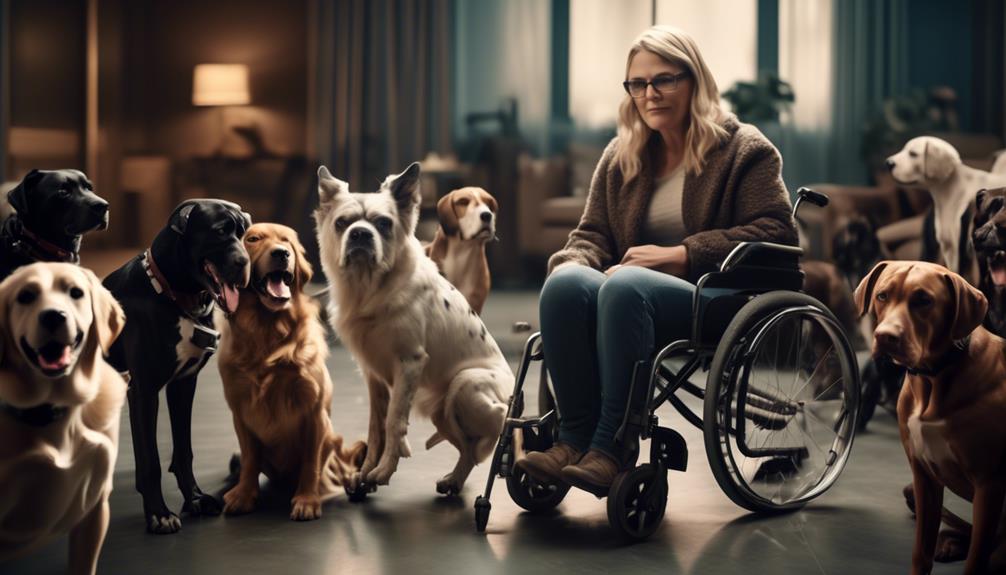
Finding the perfect companion dog for someone with limited mobility requires careful consideration of several factors: size, temperament, and maintenance.
Size is an important consideration as the dog should be small enough to be easily manageable for the person with limited mobility. A smaller dog will be easier to handle, both in terms of physical strength and space requirements. Additionally, a smaller dog will generally require less exercise, which can be beneficial for someone with limited mobility.
Temperament is another crucial factor to consider. The dog should have a calm and gentle temperament, as they will be spending a significant amount of time indoors with their owner. A dog that is easily trainable and has a low energy level may be a good fit for someone with limited mobility.
Maintenance is also an important consideration when choosing a companion dog. The person with limited mobility may have difficulty grooming and caring for a dog with high maintenance requirements. Therefore, a dog with a short coat that requires minimal grooming may be more suitable.
In conclusion, finding the perfect companion dog for someone with limited mobility involves considering factors such as size, temperament, and maintenance. By carefully considering these factors, it is possible to find a dog that will be a loyal and loving companion for someone with limited mobility.
Key Takeaways
- Size: Choose a dog that is small enough to be easily manageable for someone with limited mobility.
- Temperament: Look for a dog with a calm and gentle temperament to provide emotional support.
- Maintenance: Consider a dog with a short coat that requires minimal grooming to make it easier for the owner to care for.
- Physical support: Ensure the dog has the physical capabilities to provide balance and mobility assistance for the owner.
Considerations for Limited Mobility
When considering a companion dog for limited mobility, it's important to take into account several key factors to ensure a suitable match for your specific needs. One of the most important considerations is the dog's ability to provide physical support for balance and mobility. Dogs that are trained to assist people with disabilities can be trained to provide physical support by walking alongside the person, offering stability and balance. This is especially important for individuals who may have difficulty walking or maintaining their balance on their own.
Another factor to consider is the breed of dog. Some breeds are better suited for providing physical support than others. Breeds such as Labrador Retrievers, Golden Retrievers, and German Shepherds are often chosen for their size, strength, and trainability. These breeds have the physical capability to offer the necessary support and can be trained to perform specific tasks to assist individuals with limited mobility.
It is also important to consider the grooming and maintenance needs of the dog. For individuals with limited mobility, it may be difficult to groom and care for a dog with high grooming needs. Choosing a dog with minimal grooming requirements can help ensure that the dog's care is manageable for the individual.
Matching Energy Levels and Exercise Needs
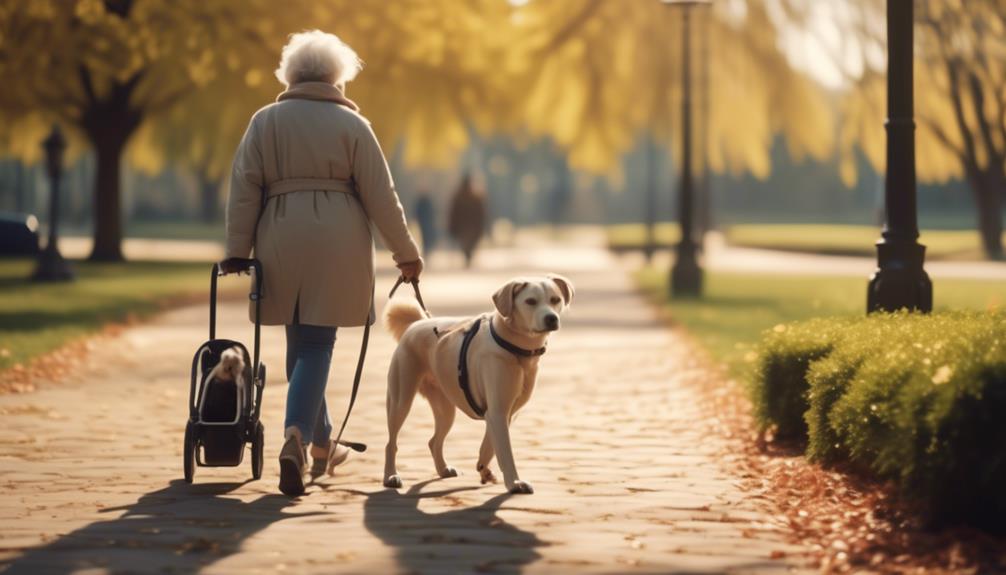
Considering the importance of matching energy levels and exercise needs when choosing a companion dog for limited mobility, it's crucial to ensure that the dog's activity requirements align with the owner's capabilities and lifestyle. This ensures a harmonious and manageable companionship that caters to both the physical disabilities or mobility impairments of the owner and the exercise needs of the dog.
Here are three key factors to consider when matching energy levels and exercise needs:
- Breed Energy Level: Different dog breeds have different energy levels. Some breeds, such as Border Collies and Jack Russell Terriers, have high energy levels and require extensive exercise to stay happy and healthy. On the other hand, breeds like Bulldogs and Basset Hounds have lower energy levels and are more laid-back. It's important to select a breed that matches the owner's exercise capabilities and can adapt to their mobility restrictions.
- Exercise Requirements: Dogs require physical activities to maintain their overall well-being. When choosing a companion dog for someone with limited mobility, it's essential to consider the exercise requirements of the breed. Some dogs may need daily walks, while others may require more vigorous activities like running or playing fetch. The exercise needs of the dog should be comfortably manageable within the owner's mobility restrictions.
- Lifestyle Compatibility: A dog's exercise needs should align with the owner's lifestyle. If the owner leads a sedentary lifestyle or has limited mobility, it's best to choose a dog breed that doesn't require excessive exercise. This ensures that the owner can adequately care for the pet without compromising their own health and well-being.
Matching energy levels and exercise needs is crucial when choosing a companion dog for someone with limited mobility. By considering the breed energy level, exercise requirements, and lifestyle compatibility, one can find a dog that will be a suitable and sustainable companion, providing both joy and companionship to the owner.
Size and Physical Requirements
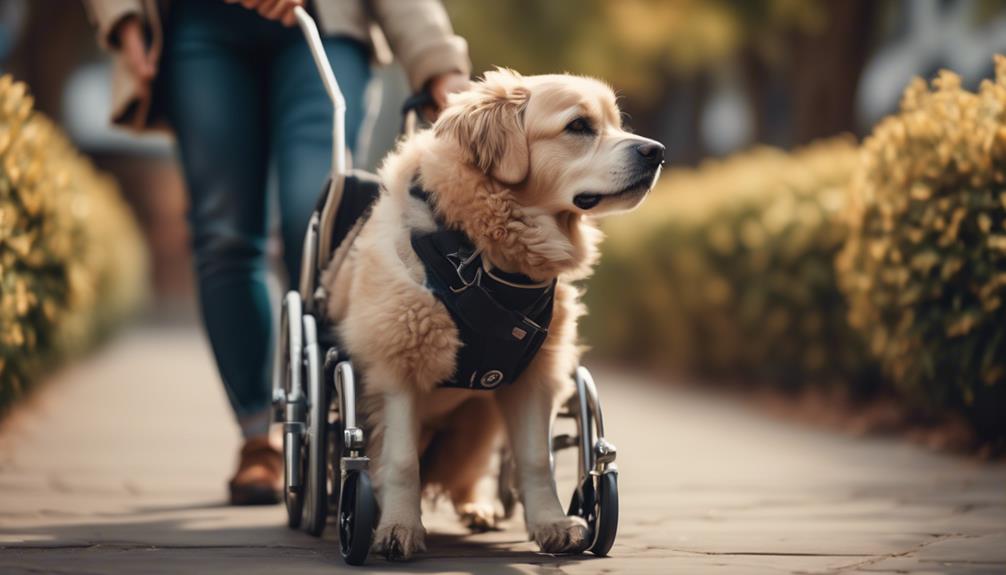
One important consideration when choosing a companion dog for limited mobility is ensuring that the dog's size and physical requirements align with the owner's specific needs. Service dogs or mobility assistance dogs play a crucial role in supporting individuals with limited mobility, and their physical characteristics greatly impact their ability to perform tasks effectively.
When it comes to size, it's essential to select a dog that meets the minimum requirements for tasks such as pulling a wheelchair or providing support for walking. The dog should have the strength and stability to assist the owner in their daily activities. Larger breeds such as Bernese Mountain Dogs and Golden Retrievers are often chosen for their size and physical capabilities.
In addition to size, the dog's physical attributes should also be considered. It's important to choose a dog that can comfortably wear the necessary harness for mobility assistance. The height and build of the dog should be taken into account to ensure a proper fit. Furthermore, the breed's fur should align with the owner's maintenance capabilities and potential allergies. Factors such as shedding, grooming requirements, and odor when wet should be considered to ensure a comfortable living environment for both the owner and the dog.
Temperament and Personality Traits
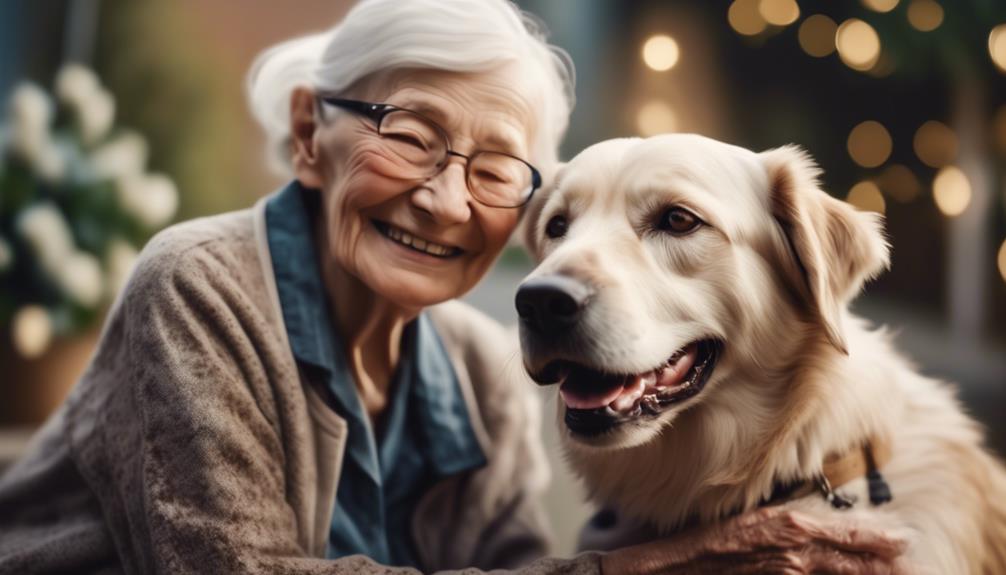
A dog's temperament and personality traits are crucial factors to consider when selecting a companion dog for limited mobility. Here are three key aspects to keep in mind:
- Calm and Gentle Demeanor: It's important to choose a dog with a calm and gentle temperament, especially if you have limited mobility. Dogs with a relaxed disposition are more likely to provide a soothing and comforting presence, which can be beneficial for individuals with mobility challenges.
- Loyalty and Emotional Support: Look for a breed known for its loyalty and willingness to provide emotional support. Dogs that are naturally inclined to form strong bonds with their owners can offer companionship and emotional stability, enhancing the overall well-being of individuals with limited mobility.
- Trainability and Task Assistance: Consider a dog that's intelligent, trainable, and capable of learning specific tasks to assist with mobility. Dogs that can be easily trained to perform tasks such as retrieving objects or providing physical support, like stability when walking, can greatly enhance the independence and mobility of their owners.
Trainability and Assistance Skills
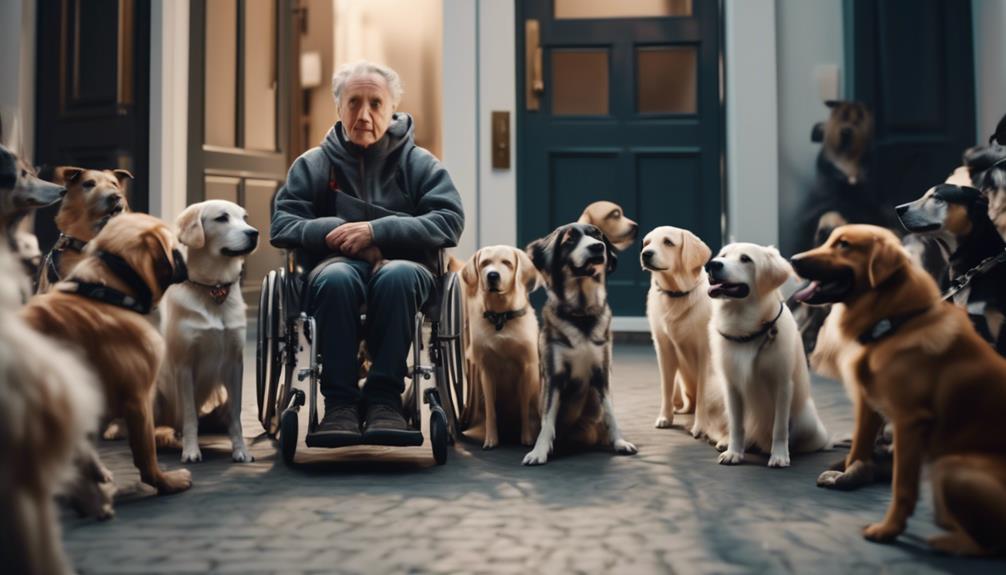
Trainability is a crucial factor to consider when selecting a companion dog for limited mobility, as it directly impacts their ability to learn and perform assistance skills. When choosing a dog, it's important to look for breeds known for their intelligence and ease of training. These breeds can quickly pick up tasks that aid in mobility, making them ideal for individuals with limited mobility.
Additionally, it's essential to consider the specific assistance skills needed. For example, retrieving objects or providing physical support may be necessary. Therefore, choosing a dog that can be trained for these specific tasks is vital. Some breeds are naturally inclined towards assistance work, which makes them excellent candidates for providing mobility support. However, it's important to assess the individual dog's potential for learning and adapting to assistive tasks. Each dog is unique, and their trainability may vary.
Grooming and Maintenance Requirements
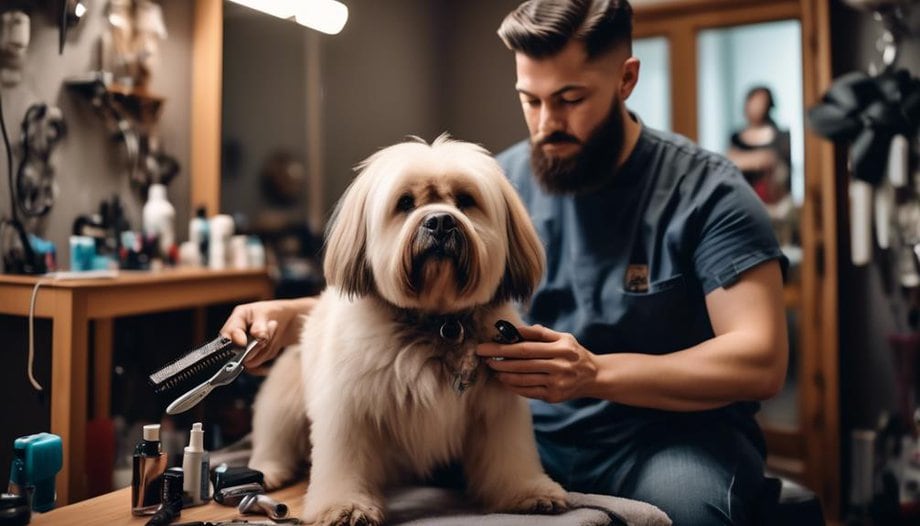
Grooming and maintenance requirements play a crucial role in selecting a companion dog for individuals with limited mobility. When choosing a dog breed for someone who needs assistance, it's important to consider the grooming and maintenance needs of the dog. Here are three key points to keep in mind:
- Dog breeds: Different dog breeds have different grooming needs. Some breeds require regular brushing to keep their coats clean and free from mats and tangles. Others may need professional grooming to maintain their appearance. It's essential to research the specific grooming requirements of different breeds to ensure that the individual with limited mobility can meet their dog's needs.
- Training: Dogs that are trained to assist individuals with limited mobility may require additional grooming and maintenance. These dogs often work in various environments and may need regular bathing to keep them clean and odor-free. It's essential to consider the training requirements and grooming needs of assistance dogs to ensure that they receive proper care.
- Allergies and shedding: Individuals with limited mobility who have allergies or prefer a cleaner living environment may want to consider dog breeds that don't shed or have minimal shedding. These breeds are easier to maintain as they don't leave excessive hair on furniture or clothing. Additionally, individuals with allergies may find it more comfortable to be around dogs that don't shed.
Accessible Living Arrangements
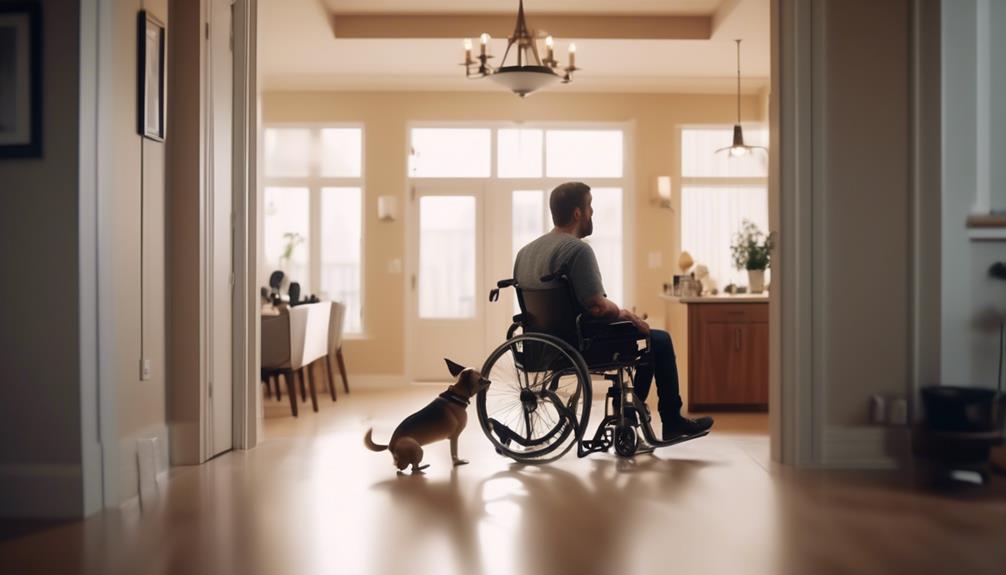
When considering a companion dog for individuals with limited mobility, it is important to carefully assess the accessibility of their living arrangements. Ensuring that the living space is suitable for both the individual and the dog is crucial for their comfort and safety. Here are some factors to consider when evaluating the accessibility of living arrangements:
| Accessible Living Arrangements | Considerations |
|---|---|
| Size and Layout of Living Space | The size and layout of the living space should allow the dog to move freely without hindering the individual's mobility. It is important to have enough space for the dog to comfortably navigate and perform tasks. |
| Accessibility Features | Living arrangements should have appropriate accessibility features such as ramps, wide doorways, and non-slip flooring to facilitate the individual's mobility and the dog's movements. These features enhance the overall accessibility of the living space. |
| Safety Measures | Safety measures like grab bars, handrails, and adequate lighting should be in place to ensure the safety of both the individual and the dog. These measures reduce the risk of accidents and provide a secure environment for daily activities. |
| Outdoor Space | Having access to a suitable outdoor space is essential for the dog's exercise and bathroom needs. The outdoor area should be securely fenced and free from hazards to ensure the dog's safety while allowing them to enjoy outdoor activities. |
| Environmental Factors | Consider any potential environmental factors that may affect the individual or the dog's well-being, such as noise levels, air quality, and proximity to necessary amenities. These factors contribute to the overall comfort and quality of life for both the individual and the dog. |
Frequently Asked Questions
What Is the Best Dog for Low Mobility?
The best dog for low mobility is one that provides companionship, emotional support, and reduces loneliness. Breeds like Labrador Retrievers, Golden Retrievers, or Standard Poodles are good options due to their friendly nature and ability to assist with daily tasks.
What Is the Best Dog for a Physically Disabled Person?
When choosing a dog for a physically disabled person, it's essential to consider factors such as the benefits of therapy dogs, training requirements, common breeds, and tips for introducing a new companion.
What Is the Best Pet for a Disabled Person?
Alternative pet options for individuals with limited mobility include companion dogs. Factors to consider when choosing a companion dog for someone with limited mobility are size, temperament, trainability, and the ability to assist with specific tasks.
What Is the Best Service Dog for a Wheelchair?
When selecting a service dog for a wheelchair user, it's important to consider the benefits, training requirements, and tasks they can assist with. Personal stories and experiences of wheelchair users highlight the invaluable support these dogs provide.









